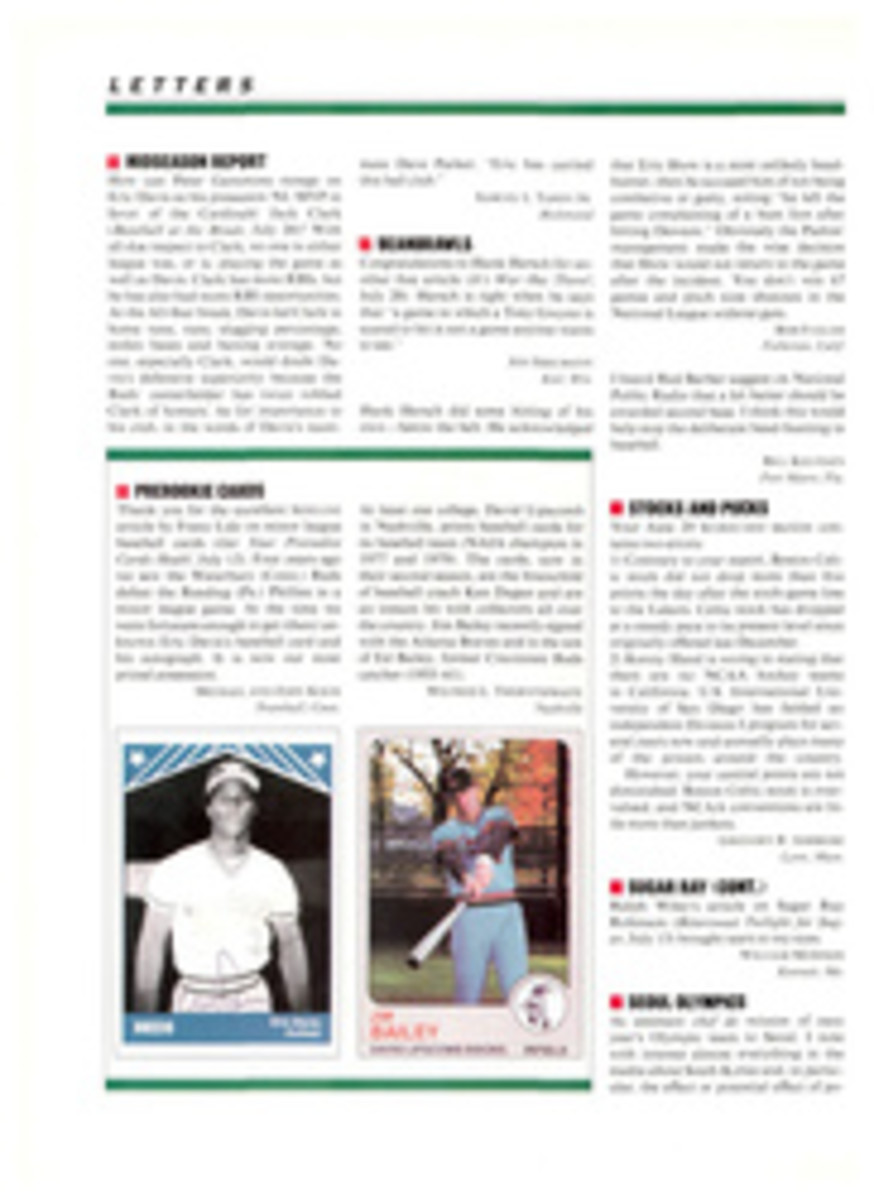
THE DASHING, SPLASHING FATHER OF WATERSKIING
On June 29, 1922, 18-year-old Ralph Samuelson of Lake City, Minn., skittered briefly across the surface of Lake Pepin on huge homemade water skis and unwittingly invented a sport. The significance of his accomplishment didn't occur to Samuelson at the time, which helps explain why it took 44 years for the world to find out about him.
Samuelson was a thrill-seeking river rat who spent much of his time on Lake Pepin, a picturesque 30-mile-long, 3-mile-wide section of the Mississippi 60 miles southeast of the Twin Cities. As detailed in an unpublished biography written by the late Gregor Ziemer, Samuelson enjoyed bouncing across the lake on his aquaplane, a large, flat board that he tied behind his older brother Ben's powerboat. Ralph liked riding while balancing on a friend's shoulders or standing on his head on a chair.
In the winters, he took to the lake in an iceboat and skied down the bluffs along the shore, which gave him an idea. Perhaps his snow skis, or reasonable facsimiles thereof, would take him across water. He made his first attempts in the spring of 1922 behind his brother's boat. He tried snow skis and sank. He tried barrel staves and sank again. A group of schoolboys regularly gathered on shore to watch his attempts. In Lake City (pop. 2,500), Samuelson was news. "Everyone, of course, thought I was nuts," he told Ziemer years later.
Before long Samuelson realized that with the boat's top speed of less than 20 mph, he needed skis with more surface area to help him stay on top of the water. He bought two eight-foot-long, nine-inch-wide pine planks at a local lumberyard, softened one end of each in his mother's wash boiler and curved the ends up by clamping them in vises. He fastened a leather strap in the middle of each ski to hold his feet in place, bought 100 feet of sash cord to use as a tow rope and had a blacksmith make him an iron ring, four inches in diameter, to serve as a handle, which he insulated with tape.
Samuelson's first successful ride on the skis came when he lugged them along on the aquaplane and put them on as his brother eased the boat up to its top speed. Then, one ski at a time, Samuelson stepped off one side of the aquaplane and managed to stay upright for a few yards before he fell.
Abandoning this approach, Ralph then tried to start on the skis from deep water. After three days of heading toward the bottom of the lake as soon as he yelled for his brother to take off, he thought of keeping the tips of the skis out of the water on the start. On July 2, a day before his 19th birthday, Samuelson went from sitting in the water to skiing on top of it, and he considered that the highlight of his week. Now the local boys who had waited for him to break his neck crowded around when Samuelson came in to shore. "We asked two questions," recalls longtime resident Ben Simons, who was seven years old at the time. " 'How'd you do it?' and 'Can you do it again?' "
Samuelson could. As he added new tricks to his waterskiing repertoire, the crowds grew. Photos of him began appearing in area newspapers. Lake City officials offered to pay for the gas he used, and when Samuelson charged admission to his weekend waterskiing exhibitions, he turned the money over to the town. In 1923 a small bandstand was built beside the lake, and a band often accompanied his performances.
Samuelson combined showmanship with a daring that bordered on recklessness, and spectators—who sometimes numbered more than 1,000—usually got their money's worth. In July 1925 he became the world's first water-ski jumper, riding over a partly submerged diving platform greased with lard. The following month a barnstorming pilot named Walter Bullock flew into Lake City in a World War I-vintage Curtiss MF flying-boat, offering rides above the lake for $2. Samuelson, who had yet to find a boat fast enough to satisfy him, asked Bullock if he might ski behind the plane. They would draw a large crowd, he explained, and no doubt stimulate Bullock's business. Bullock agreed.
With Samuelson at the end of a 200-foot rope, Bullock got the plane going, planning to lift off and fly a few feet above the water. As he neared 60 mph, the plane's propeller began to pick up water and push it back toward the skier. The drops felt like bullets on Samuelson's face, but, too scared to let go, he held on—even as the plane, unsuccessful in its attempts to take off, bounced on the water, jerking Samuelson right out of his skis. He landed on his stomach and slid for what felt like a city block, suffering minor abrasions. Still, he later insisted that "my first thought wasn't for my safety, but whether I'd lost my swimming suit."
The next time, they used a proper promotional campaign. Samuelson had hundreds of handbills printed, announcing that "a death-defying ride on water skis...behind a flying boat" would take place in Lake City the following weekend. He took off with Bullock in the plane, and they dropped the literature over the surrounding towns. The next weekend, as reported on the front page of the Aug. 28, 1925, Wabasha County Leader, "2,000 people were given a real thriller when Ralph Samuelson of this city did water skiing behind a seaplane that sped through the water at a dizzy pace and at times flew a few feet above the water." This time the dizzy pace, according to Bullock's air-speed indicator, was 80 mph.
In the meantime, Samuelson's father, Charles, whose grocery business had failed, scraped together enough money to invest in some acreage near Palm Beach, Fla. He and Ralph took a trip south in the fall of '25 to build a small house on the property. Ralph liked what he saw and returned to Florida the following year with his water skis. He found a job with a boat livery and skied during the intermissions of speedboat races. In the middle of one exhibition, he hit a large yacht wake, which wrenched one of the skis from his foot. He was able to finish on the other one, and thereafter he incorporated slalom skiing into his routine.
While in Florida, Samuelson often came across tourists from France, some of whom tried waterskiing. Samuelson was pretty sure that they also took the idea home and perfected this new sport on their own—which could explain why some encyclopedias credited the French Riviera of the late 1920s with being the birthplace of waterskiing.
In March 1927, less than five years after Samuelson's waterskiing career began, it ended when he broke his back in a construction accident at the Palm Beach boat livery. Thoroughly depressed, he went home to Lake City and stuck the skis in the rafters of his family's boat-house. He disappeared from Lake Pepin, but the skis reappeared in the early 1950s on the wall of Lake City's new bathhouse, under a hand-lettered placard that read WORLD'S FIRST WATER SKIS. Thousands of people were now enjoying the sport, and Simons, who had witnessed the beginning of Samuelson's adventure and was then Lake City's waterfront supervisor, had taken it upon himself to preserve what he guessed were pieces of aquatic history.
The skis hung there until the summer of 1963, when Margaret Mason (then Margaret Crimmins), who worked for the St. Paul Pioneer Press Dispatch, came to Lake City on a vacation. One day Mason wandered into the bathhouse, noticed the skis and asked about them. Simons told her Samuelson's story, adding that, though he hadn't seen Samuelson in 15 years, he thought he still lived in the area.
Although a novice skier Mason asked if she could try the skis, and Simons found her a towboat. Mason survived a rather challenging ride—the skis are gargantuan by modern standards—then returned to St. Paul to look into the history of the sport. She found variations on the French Riviera theme. Then she realized that she might have the real story herself. Mason wrote an open letter to Samuelson in her Sunday column on July 28, 1963, under the not entirely correct headline: YOUR OLD WATER SKIS ARE GREAT, MR. SAMUELSON—MR. SAMUELSON?
"I'd like to hear how you got up the first time," Mason wrote. "How many spills did you have before you were upright...? I had two—good flying smashes—before I stood up." The column continued: "Where are you now, Mr. Samuelson? I wish I knew. So do Simons and a lot of other Lake Cityites who are proud of their native son."
At the time, Samuelson and his second wife, Hazel, were living on Pine Island, 30 miles southwest of Lake City. "A local druggist came by with the paper," says Hazel, who is now in her late 60's. "He said, 'Have you seen this? Somebody's looking for you, Ralph.' "
Surprised and delighted, Samuelson took his scrapbooks full of photos and clippings up to St. Paul and spent hours describing his experiences to Mason. She discovered that in the intervening years, Samuelson had some very up—and some woefully down—years in the turkey-breeding business. He eventually found more stable work with the Minnesota highway department. And though nothing much happened after her first story about him, a second one in 1965 attracted the attention of the American Water Ski Association, the sport's governing body. (Wrote Ziemer, "Posterity should probably recognize [Mason] as the fairy godmother of water skiing.")
The association for years had credited Fred Waller of Huntington, N.Y., with the invention of the sport. He first skied on Long Island Sound in 1924 and patented his "Dolphin Akwa-Skees" a year later. But the yellowed clippings in Samuelson's scrapbook and on file with the Minnesota Historical Society were beyond dispute, and in February 1966 the AWSA officially recognized him as the father of waterskiing.
Over the next 12 years, until he died of cancer in August 1977, Samuelson was honored at boat shows and water-ski tournaments around the country. Lake City celebrates Water Ski Days one weekend every June with parades and water-ski exhibitions. On the shore of Lake Pepin, two monuments—a fountain in the shape of a wave and a historical marker with a plaque—pay tribute to Samuelson's achievement. And in 1982 one of his fondest wishes was fulfilled posthumously when he was named a charter member of the Water Ski Hall of Fame in Winter Haven, Fla. His skis are now enshrined there.
PHOTO
AMERICAN WATER SKI MUSEUM
In 1925, Samuelson latched on to a Curtiss MF flying-boat and went skiing at 80 mph.
Free-lance writer Jim Harmon learned to water-ski 20 years ago this summer.

